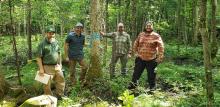Submission information
Brasher State Forest, The Nexus between Forest Research and Partnerships for Success

The Brasher State Forest has been a focal point for collaborative forest resource management between the Akwesasne Mohawk community, Academic, State, and Federal partners. Since the early 1990's, the site has provided opportunities for research on black ash, silvicultural practices, and shared resource management including direct input in to the New York State forest management plans. Over 3 decades, the span of multiple careers the partnerships have generated a wealth of information about black ash and now Emerald Ash Borer management. The contributions of each partner has increased the knowledge about ash management, tribal cultural practices, forest pest management, and has been a model for success.
Site Location
Brasher, New York
Focal point for Fraxinus nigra Marsh (black ash) restoration studies.
-74.764500
44.836898
The Brasher State Forest site is located north, a mile and a quarter off from the Brasher Falls-Deer River Road.
Access is through a seasonal road that leads to multi-use trail that leads east into the site.
Stand Information
Approximately 375 acres, mixed lowland and hardwood swamp.
Northern Hardwoods
Other (Forested)
This forest is a Northern Hardwood/Swamp Hardwood Black Ash Wetland forest type with later successional growth.
emerald ash borer
emerald ash borer
Loamy find sand/Muck soils
Pre-treatment Conditions
During the early 1800s, settlement began in small communities such as Brasher Falls, Brasher Center, Brasher Iron Works, and Helena. Most of the early settlers were farmers; however, an iron foundry was begun in 1835 in the hamlet of Brasher Iron Works. The local wetlands contained slowly forming "bog ore" which was unlike the typical iron ore found in rocks and hills. The availability of iron ore also encouraged the development of local manufacturers. The Kennehan Agricultural Works in Brasher Falls was a well-known maker of plows and other farm implements from the 1870s until the 1960s. Much of the land acquired by the state during the 1930s and 1940s was farm or pasture land in poor condition. The Civilian Conservation Corps (CCC) played a major part in reforesting these areas. Over 6,500 acres of open land was planted with pine, spruce, and larch plantations. These areas now comprise a large and important part of the state. Some of the buildings constructed in the CCC era are still in use at the DEC maintenance facility in Brasher Falls. The state forests are managed to provide a steady and renewable supply of wood products such as firewood, pulpwood, posts, poles, and sawtimber. Much of the land that was in poor condition 70 years ago has recovered and has grown into young hardwood forest containing maple, oak, beech, and elm. The black ash wetlands community type that is especially important in this unit is Black ash (Fraxinus nigra) grows in seasonally wet swamp hardwood stands, along with red maple, green ash, elms, aspen, yellow birch, and white cedar. It has a narrow range of growing conditions in which it reaches its best form and quality, and it is sensitive to changes in hydrology, such as those caused by beaver activity. (http://dec.ny.gov/places/bombay-and-brasher-state-forests)
Silviculture Prescription
Black ash is very important to local Native American culture. Artistans in the Mohawk community use black ash for the construction of pack baskets, utilitarian and ornamental baskets, as well as other items. Basket qualiy ash volume is unmanaged stands are low. Basket trees must meet exacting standards, such as being very straight with no limbs on the lower bole, minimum diameter of 10-14", and a uniform growth rate. Very few black ash trees in the given stand meet all these requirements. Stand inventories indicated overstocked even-aged stands. Black ash stands are grouped in as a Natural Area category by the New York State Department of Environmental Conservation, which means they will not undergo commercial timber harvesting, and in most cases, will receive little active management. Natural Areas are stands which will not receive scheduled management. Stands such as wetlands, stream and river buffers, and forested stands which are marginally wet or inaccessible are included in this category. In general, timber management will be minimal in these areas and they will be allowed to gradually develop late successional characteristics. In the event of natural disturbances, such as windstorms, ice storms, or insect and disease outbreaks, salvage harvests of timber will be very limited or will not occur in these areas. Treatments to control invasive species or re-establish a more native species mix will be considered if they improve the long-term health and sustainability of the area. Low intensity recreational usage will be allowed. Due in part to a large number of wetlands and limited access.
The primarily goal was to reduce stock by thinning to increase growth and volume, promote regeneration in favor of black ash balanced with associate species and to diversify age classes. Although, initially forest pest management wasn't a priority consideration, in retrospect the goal did reduce the risk of homogeneity and damage for pests. Later, as it became known that EAB would eventually arrive, the focus shifted toward preservation of seed producing trees, salvaging material for basket makers and continuing with studies focused on EAB management. EAB management consisted of continued silviculture treatments, utilization of parasitoid wasps and pesticide injections.
Primary objectives of the landowner are preserve seed producing trees, salvage material for basket makers, and continue to focus on EAB management.
Post-treatment
Post-treatment consists of monitoring of tree health, wasp population, and seed collection. Partnerships continue to be important and support the capacity of other Tribal nations to respond to EAB and future forest pests.
Miscellaneous
Black Ash, Brown Ash, Native American Basketry, Emerald Ash Borer
Statistics
Contact Information
Les Benedict
Environment Division Assistant Director. Akwesasne Task Force of the Environment, Black Ash Coordinator.
Saint Regis Mohawk Tribe